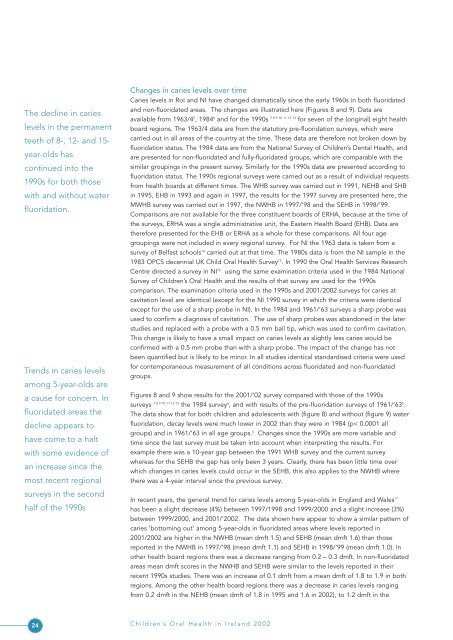Oral Health inside - Communities and Local Government
Oral Health inside - Communities and Local Government
Oral Health inside - Communities and Local Government
You also want an ePaper? Increase the reach of your titles
YUMPU automatically turns print PDFs into web optimized ePapers that Google loves.
The decline in carieslevels in the permanentteeth of 8-, 12- <strong>and</strong> 15-year-olds hascontinued into the1990s for both thosewith <strong>and</strong> without waterfluoridation.Trends in caries levelsamong 5-year-olds area cause for concern. Influoridated areas thedecline appears tohave come to a haltwith some evidence ofan increase since themost recent regionalsurveys in the secondhalf of the 1990sChanges in caries levels over timeCaries levels in RoI <strong>and</strong> NI have changed dramatically since the early 1960s in both fluoridated<strong>and</strong> non-fluoridated areas. The changes are illustrated here (Figures 8 <strong>and</strong> 9). Data areavailable from 1963/4 5 , 1984 6 <strong>and</strong> for the 1990s 7 8 9 10 11 12 13 for seven of the (original) eight healthboard regions. The 1963/4 data are from the statutory pre-fluoridation surveys, which werecarried out in all areas of the country at the time. These data are therefore not broken down byfluoridation status. The 1984 data are from the National Survey of Children’s Dental <strong>Health</strong>, <strong>and</strong>are presented for non-fluoridated <strong>and</strong> fully-fluoridated groups, which are comparable with thesimilar groupings in the present survey. Similarly for the 1990s data are presented according tofluoridation status. The 1990s regional surveys were carried out as a result of individual requestsfrom health boards at different times. The WHB survey was carried out in 1991, NEHB <strong>and</strong> SHBin 1995, EHB in 1993 <strong>and</strong> again in 1997, the results for the 1997 survey are presented here, theMWHB survey was carried out in 1997, the NWHB in 1997/’98 <strong>and</strong> the SEHB in 1998/’99.Comparisons are not available for the three constituent boards of ERHA, because at the time ofthe surveys, ERHA was a single administrative unit, the Eastern <strong>Health</strong> Board (EHB). Data aretherefore presented for the EHB or ERHA as a whole for these comparisons. All four agegroupings were not included in every regional survey. For NI the 1963 data is taken from asurvey of Belfast schools 14 carried out at that time. The 1980s data is from the NI sample in the1983 OPCS decennial UK Child <strong>Oral</strong> <strong>Health</strong> Survey 15 . In 1990 the <strong>Oral</strong> <strong>Health</strong> Services ResearchCentre directed a survey in NI 16 using the same examination criteria used in the 1984 NationalSurvey of Children’s <strong>Oral</strong> <strong>Health</strong> <strong>and</strong> the results of that survey are used for the 1990scomparison. The examination criteria used in the 1990s <strong>and</strong> 2001/2002 surveys for caries atcavitation level are identical (except for the NI 1990 survey in which the criteria were identicalexcept for the use of a sharp probe in NI). In the 1984 <strong>and</strong> 1961/’63 surveys a sharp probe wasused to confirm a diagnosis of cavitation. The use of sharp probes was ab<strong>and</strong>oned in the laterstudies <strong>and</strong> replaced with a probe with a 0.5 mm ball tip, which was used to confirm cavitation.This change is likely to have a small impact on caries levels as slightly less caries would beconfirmed with a 0.5 mm probe than with a sharp probe. The impact of the change has notbeen quantified but is likely to be minor. In all studies identical st<strong>and</strong>ardised criteria were usedfor contemporaneous measurement of all conditions across fluoridated <strong>and</strong> non-fluoridatedgroups.Figures 8 <strong>and</strong> 9 show results for the 2001/’02 survey compared with those of the 1990ssurveys 7 8 9 10 11 12 13 the 1984 survey 6 , <strong>and</strong> with results of the pre-fluoridation surveys of 1961/’63 5 .The data show that for both children <strong>and</strong> adolescents with (figure 8) <strong>and</strong> without (figure 9) waterfluoridation, decay levels were much lower in 2002 than they were in 1984 (p< 0.0001 allgroups) <strong>and</strong> in 1961/’63 in all age groups. 5 Changes since the 1990s are more variable <strong>and</strong>time since the last survey must be taken into account when interpreting the results. Forexample there was a 10-year gap between the 1991 WHB survey <strong>and</strong> the current surveywhereas for the SEHB the gap has only been 3 years. Clearly, there has been little time overwhich changes in caries levels could occur in the SEHB, this also applies to the NWHB wherethere was a 4-year interval since the previous survey.In recent years, the general trend for caries levels among 5-year-olds in Engl<strong>and</strong> <strong>and</strong> Wales 17has been a slight decrease (4%) between 1997/1998 <strong>and</strong> 1999/2000 <strong>and</strong> a slight increase (3%)between 1999/2000, <strong>and</strong> 2001/’2002. The data shown here appear to show a similar pattern ofcaries ‘bottoming out’ among 5-year-olds in fluoridated areas where levels reported in2001/2002 are higher in the NWHB (mean dmft 1.5) <strong>and</strong> SEHB (mean dmft 1.6) than thosereported in the NWHB in 1997/’98 (mean dmft 1.1) <strong>and</strong> SEHB in 1998/’99 (mean dmft 1.0). Inother health board regions there was a decrease ranging from 0.2 – 0.3 dmft. In non-fluoridatedareas mean dmft scores in the NWHB <strong>and</strong> SEHB were similar to the levels reported in theirrecent 1990s studies. There was an increase of 0.1 dmft from a mean dmft of 1.8 to 1.9 in bothregions. Among the other health board regions there was a decrease in caries levels rangingfrom 0.2 dmft in the NEHB (mean dmft of 1.8 in 1995 <strong>and</strong> 1.6 in 2002), to 1.2 dmft in the24 Children’s <strong>Oral</strong> <strong>Health</strong> in Irel<strong>and</strong> 2002
















